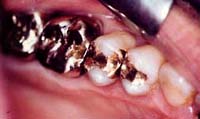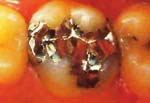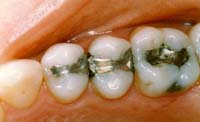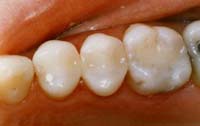




There are many materials used to restore teeth; I would like to discuss several of the most frequently used ones. Amalgam is used because it can be performed quickly and economically, is a strong material, and holds up well over time. Composites provide an esthetic alternative for restoring back teeth and is the material of choice for front teeth. The current generation of composite materials has improved in physical characteristics; these restorations take more time to perform, resulting in a higher fee than amalgams. Gold is the strongest and most biocompatible material. It is time consuming and requires two appointments to complete. Porcelain is the most esthetic material and achieves a very natural appearance which is often indistinguishable from natural tooth enamel.
Are amalgam restorations (silver fillings) safe? Are there alternative materials that can be used? The answer to both of these questions is yes. For more than one hundred years, billions of amalgam fillings have been used to restore decayed teeth. Amalgam has been proven a superior material because of its durability, longevity, ability to withstand the pressures of chewing, ease of placement, and cost effectiveness. All amalgam restorations contain various metals, such as silver, copper, and tin, as well as mercury. Mercury is necessary to chemically bind these elements together to form a hard, stable restorative material. When mercury is combined with these metals it becomes an inactive substance. Mercury is a naturally occurring element in the environment and can be found in trace amounts in food, water, and air. Consequently, there is always a very low level of mercury present in the human body. The daily dosage of mercury from non-dental sources exceeds the miniscule amounts released from amalgam fillings. There have been reports in the media of people being cured from a variety of illnesses when amalgam fillings are removed. These reports are not true! An overnight cure from serious disease is not supported by scientific evaluation. The Food and Drug Administration has concluded that, properly placed, amalgam causes no demonstrated clinical harm to patients and that removing existing amalgam fillings will not prevent ill health or reverse the effects of existing diseases.
Gold is one of the most biocompatible material used in dentistry. Gold retains its physical properties (it does not degrade in the oral environment) for the life of the restoration. Because gold expands and contracts at the same rate as the natural tooth it does not stress the remaining tooth structure. The gold restoration can be fabricated with precision to fit precisely within the tooth.
 fig.2 These gold inlays and crowns
fig.2 These gold inlays and crownshave been in place for over twenty years with no signs of degradation. They are in areas of the teeth and mouth that are not visible when the patient smiles.
For patients who do not want metal fillings or in areas of the mouth that are visible, the filling materials of choice are composites. These materials have made great strides in recent years and have improved to the point where they can be used with confidence. Composites are made of a plastic resin and a filler of finely ground glass-like particles. These materials can be blended and matched to the color of the existing tooth. The procedure to fill a tooth with composites is more precise and takes longer to perform than an amalgam filling. These materials are bonded to the remaining tooth structure. This gives the filling a strong and secure attachment to the remaining tooth. Generally, these materials are not as long-lasting as amalgam or gold, nor should they be used where a large filling or a crown is needed due to the loss of a large amount of tooth structure. In smaller fillings, especially where esthetics are important, composites are the answer.
Porcelain is the most esthetic material used in dentistry. It can be used for crowns, fillings, and as veneers to achieve a very natural appearance. Porcelain can be fused to metal when used as a crown. This provides a highly reflective, color stable material which achieves an esthetically pleasing and structurally strong tooth restoration. Porcelain will not change color after it is fabricated and cemented in place. This is not the case with other tooth colored materials.
|
Bonding | Veneers | Crowns | Bleaching | Recontouring | Periodontal Disease | Fluoride | Sealants | Prevention | Tooth Topics | History | Children | Endodontics | Materials | TMD | FAQ | Prosthodontics | Implants
 fig.1 This well-placed amalgam, in an area
fig.1 This well-placed amalgam, in an area

 fig.5 This image shows a porcelain-fused-to-metal crown, a natural-appearing tooth restoration. The tooth next to it is restored with a very large amalgam, while not the most ideal solution, it has functioned well for over twenty years.
fig.5 This image shows a porcelain-fused-to-metal crown, a natural-appearing tooth restoration. The tooth next to it is restored with a very large amalgam, while not the most ideal solution, it has functioned well for over twenty years.